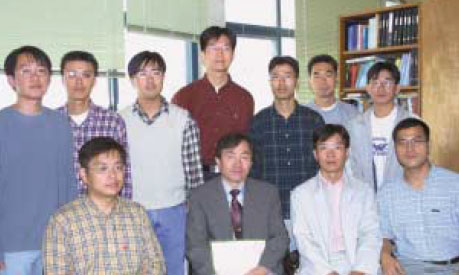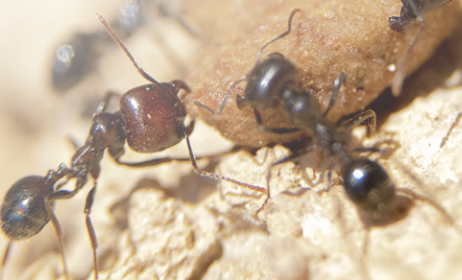공룡이(그리고 다른 일부의 생명체도) 상당히 큰 운석이나 혜성이 지구와 충돌하는 바람에 절멸했다는 학설이 10여년 전에 등장했다.
일부의 학자들은 이 학설에 반대하며 그 대신 공룡을 죽인 것은 거대한 화산폭발의 작용이나 다른 기상이변의 시기가 있었기 때문이라고 주장한다. 전반적으로 충돌설이 우세해졌으며 최근 이 논란을 매듭지을 새로운 증거의 한토막이 나타났다. 캘리포니아주의 '라 졸라'에 있는 '스크립스'해양연구소의 '제프리L. 베이다'가 6천5백만년 전에 가라앉은 침전물에서 아미노산을 발견했다.
아미노산은 단백질의 구성요소이다. 모든 단백질분자는 수십개내지 수백개의 아미노산으로 엮어진 한개 또는 그 이상의 끈으로 만들어져있다. 일반적으로 지상의 아미노산은 오직 생명조직에 의해서만 생선된다.
따라서 6천5백만년 전에 침전된 물질에서 아미노산을 찾아낸다는 것은 특별히 비상한 관심거리라고 할 수는 없다. 결국 당시에도 충분히 많은 생명체가 있었고 모든 생명체들은 아미노산을 만들었던 것이다. 따라서 일부 아미노산이 발견되는 것은 당연한 것이 아닌가?
우선 한 예를 든다면 이론적으로는 무수한 종류의 아미노산이 있을 수 있다. 그러나 생명유기체에 의해 만들어지는 단백질은 단지 20종의 아미노산을 이용할 뿐이다. 더욱 모든 형태의 생명체는 그것이 바이러스이든 떡갈나무이든 또는 뱀이나 사람이든 아주 드문 예외가 있기는 하지만 같은 20종의 아미노산을 만들거나 이용한다. 생명체가 이용하는 아미노산이 왜 20종인지, 그리고 이용치 않는 다른 아미노산들에는 어떤 결함이 있는지는 아무도 모른다.
'베이다'씨에 의해 1989년 6월 오래된 바위에서 발견된 아미노산은 두 종으로 하나는 '이소발린'이고 다른 하나는 '알파-아미노이소뷰티릭산'이다. 이들은 단백질에서 발견되지 않으며 우리가 아는한 일반적으로 생명체에 의해 생성되는 것이 아니다. 드물게 균류(菌類)중에서 약간의 '이소발린'을 만들기는 하지만 매우 예외적인 일이다.
아미노산이 발견되는 다른 곳이 있을까? 그렇다. 탄소질의 '콘드라이트'라고 불리워지는 운석이 바로 그것인데 이것은 약간의 물과 탄소화합물을 갖고 있다. 탄소화합물 가운데 일부 아미노산이 있다. 그리고 실제 가끔 운석에서 발견되는 아미노산 가운데 이소발린과 알파-아미노이소뷰티릭산이 있다. 그러면 그런 아미노산을 갖고 있는 운석이나 혜성이 지구와 거대한 충돌을 일으켜 지표면에 흩뿌린 결과 아미노산이 남아있게 되었다는 것이 가능한 일이 된다.
확신할 수 있는 일일까? 희귀한 균류도 이소발린을 만든다. 아마 6천5백만년 전에 멸종한 일부 동물들이 지금은 드물지만 당시에는 그렇지 않았던 이들 아미노산을 우연히도 충분히 만들었을지도 모르는 게 아닐까?
결코 그렇지는 않다. 그런 일은 있을 수 없다고 확신할 수 있다. 생명에 중요한 다른 많은 물질과 같이 아미노산도 비대칭의 분자구조로 돼 있다. 오직 두가지 형태의 하나 즉 좌형이나 우형(장갑이나 신처럼)중 한가지 형으로만 존재할 수 있는 것이다. 생명체의 효소는 우연히도 모든 좌형의 아미노산만 만든다. 단백질분자를 구성하기 위한 유용한 고리를 만드는 데 있어 좌형의 아미노산들은 쉽게 접속이 될 수 있다. 좌형과 우형이 섞여지면 그렇게 될 수 없다. 물론 모두 우형이라면 제 기능을 할 수 있다. 그러나 35억년 전에 생명체가 처음 등장했을 때 어떤 우연한 과정에 의해 좌형이 처음부터 쓰여지게 된 것이다. 그리고 그 이후 줄곧 아미노산은 좌형으로 존속해왔다. 이소발린을 만드는 그 희귀한 균류도 좌형의 이소발린만 만든다.
그러나 만약 인공적 또는 무의도적으로 아미노산을 만들면, 보통의 화학반응에 의해 시험관에서 만들어지는 것처럼, 좌형과 우형이 같은 양으로 만들어진다. 어느 쪽도 우위를 차지하지 못한다. 운석에서 발견되는 아미노산은 같은 양으로 좌형과 우형이 병존한다. 이 사실은 살아 있는 유기체의 효소작용이 아닌 화학반응에 의해 만들어졌다는 것을 얘기해주는 것이다.
6천5백만년이 된 침전물에서 발견된 아미노산도 동량의 좌ㆍ우형 아미노산이다. 이것은 이들 아미노산이 지표면의 생명체에 의해서가 아니라 운석이나 혜성 내에서의 비 생명적 과정에 의해 만들어졌다는 강력한 표시가 되는 것이다.
물론 이런 발견에도 약간의 의문은 남아있다. 충돌시의 열에 의해 아미노산이 어떻게 파괴되지 않고 남아 있을 수 있을까? 이 문제에 대한 답변은 쉽지 않다. 아미노산은 매우 강인한 분자가 아니며 정상적으로는 그런 열을 견딜 수 없다. 아마 충돌 물체의 내부에 있어 열로부터 보호되었을지도 모른다.
더욱 의심쩍은 것은 아미노산들이 정확히 과거 6천5백만년 전의 시점을 가르키는 침전물의 열(列)에서만 발견되는 것은 아니라는 점이다.
아마 시초에는 제자리에 있었지만 수백만년의 세월이 흐르는 동안 바위의 위 아래로 표류했을지도 모른다. 이런 얘기는 그다지 설득력은 없다. 그러나 '베이다'씨는 다른 지역의 바위도 조사하고 있으며 혹시 추가된 자료가 해명을 해줄지 모른다.
About 10 years ago, the theory was advanced that the dinosaurs (and certain other living species) were killed off by the collision of a rather large meteor or comet, with the Earth.
Some scientists object to that and claim that it was a period of vast volcanic reactions or other climatic abnormalities that killed the dinosaurs. On the whole, the impact supporters have been winning and now a new piece of evidence has arisen that may clinch the matter.
In those sediments that were laid down 65 million years ago, Jeffrey L. Bada of the Scripps Institution of Oceanography in La Jolla, Calif., has discovered amino acids.
Amino acids are the building blocks of proteins. Every protein molecule is made up of one or more strings of anywhere from a dozen to several hundred amino acids. In general, amino acids on Earth are produced only by living tissue.
In that case, there should be nothing particularly. unusual about finding amino acids in materials that were laid down 65 million years ago. After all, there was plenty of life then and all the forms of life were forming amino acids. Why shouldn't some be found?
Well, for one thing there are uncounted numbers of amino acids that are theoretically possible, but the proteins formed by living organisms make use of only 20 different kinds of amino acids.
What's more, all forms of life, whether viruses or oak trees or snakes or human beings, form and make use of the same 20 amino acids, with very rare exceptions.
Nobody knows why it is those 20 that living organisms use, and what is wrong with all the others they don't use.
The amino acids reported in the old rocks by Bada in June of 1989 are, however, of two types, "isovaline" and "alpha-aminoisobutyric acid." These are not found in proteins and, as far as we know, are not formed by living things generally. A rare form of fungus does form some isovaline, but that is very exceptional.
Is there anywhere else that amino acids are found? Well, yes. There are certain meteorites called "carbonaceous chondrites" that contain small quantities of water and carbon compounds. Among the carbon compounds are some amino acids. And, as a matter of fact, among the amino acids found in occasional meteorites, are isovaline and alpha-aminoisobutyric acid. It is possible, then, that the amino acids are the result of a vast impact of a meteor or a comet that contained these amino acids and scattered them over the face of the Earth.
Can we be sure? After all, that rare fungus does form isovaline. Perhaps 65million years ago, some animals that passed into extinction happened to make copious quantities of these amino acids that are rare now, but weren't rare then.
No, we can be sure that didn't happen. Amino acids, like many other substances important to life, have asymmetric molecules and can exist in either of two forms, a left-form or a right-form (like gloves and shoes). It so happens that the enzymes of living things make amino acids that are all left-forms. Left-forms fit together easily to make useful chains for the formation of protein molecules. Left-forms and right-forms scrambled together wouldn't work. Of course, a chain made of all right-forms would work, too, but when life first formed 3.5 billion years ago, the left-forms were initially used through some random process, and amino acids have stayed left-form ever since. Even the rare fungus that forms isovaline forms only left-form isovaline.
If amino acids are formed by artificial or random processes, however, as when they are formed in the chemists' test-tubes by ordinary chemical reactions, both left-forms and right-forms appear in equal quantities. Neither one has the advantage. The amino acids that are found in meteorites are present as left-forms and right-forms in equal quantities and that tells us they were made by chemical reactions that did not involve the enzymes of living organisms.
The amino acids found in the 65-million-year-old sediments are also found in left-forms and right-forms in equal quantities, which is a strong sign that they were formed not by living things on Earth's surface, but by non-life processes in a meteor or comet.
Of course, there are some questions about this discovery. How is it that the amino acids were not destroyed by the heat of impact? There is no easy answer to that. The amino acids are not very sturdy molecules and normally could not withstand such heat. Perhaps they existed on the inside of chunks of the impacting object and were protected from the heat that way.
More puzzling is the fact that they don't occur exactly at the line of sediment that marks the time of 65 million years in the past. Perhaps they were originally in the right line but, in all those millions of years, they've managed to drift through the rocks up and down. That doesn't sound convincing, but Bada is investigating rocks in other areas, and perhaps additional data will supply explanations.
이 기사의 내용이 궁금하신가요?
기사 전문을 보시려면500(500원)이 필요합니다.
1989년 11월 과학동아 정보
🎓️ 진로 추천
- 지구과학
- 생명과학·생명공학
- 화학·화학공학

















